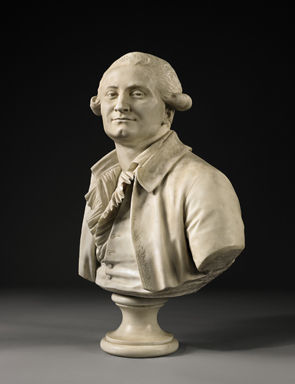Important sculpture featured at Sotheby's New York during Old Masters Week
A French marble bust of Jacques-Antoine-Hippolyte, Comte de Guibert (1743-1790), by Jean-Antoine Houdon (1741-1828), dated 1791. Signed and dated beneath his proper right arm houdon f. 1791. Overall 33 1/4 in.; 84.5 cm. Est. $800,000/1.2 million. Photo: Sotheby's.
NEW YORK, NY.- Important sculpture and works of art will be up for offer on 1 February 2013 during the second day of Sotheby’s Old Master Paintings and Sculpture sale in New York and will be highlighted by a commanding French marble bust of one of France’s foremost military tacticians Jacques-Antoine-Hippolyte, the Comte de Guibert. The bust was commissioned on 2 November, 1791 from Houdon, the preeminent portrait sculptor of his time, by the sitter's widow (est. $800/1.2 million). Guibert was a general, a writer and a friend to many of the Enlightenment's leading intellectuals, and his Essai général de tactique had an enormous impact on the science of military strategy and was admired by George Washington, Frederick the Great and the young Napoleon Bonaparte. In 1776, the year he was promoted to colonel, he was raised to the nobility as a count of the Holy Roman Empire. In 1781, he was promoted to the rank of brigadier general and in 1778 he was promoted to the rank of marechal de camp. The work, which exemplifies Houdon’s mastery of the material and his fondness for both naturalistic detail and psychological realism, conveys the sitter’s strength, intelligence and virility. This marble bust remained in the Guibert family through 1918.
A further highlight is a beautifully carved pietra serena frieze by Francesco di Simone Ferrucci (1437-1493), a talented disciple of Verrocchio, which most likely adorned the lintel of a fireplace in the palazzo of a noble Florentine family circa 1460-1470 (est. $500/700,000). The present relief is centered by the coat of arms of the Tuscan counts, Guidi di Bagno, who were one of the largest and most powerful noble families in central Italy in the Middle Ages. The majority of pieces by Ferrucci are preserved in museum collections or in their original church installations, including a similar pietra serena frieze in the Museo Bardini, Florence and another in the Pierpont Morgan Library, New York. The outstanding clarity of form and detail in this frieze is underscored by the material from which it was carved. Pietra serena is a hard and fine-grained stone from Fiesole which was employed by Tuscan sculptors throughout the Renaissance. Here, Ferrucci was able to achieve a sense of depth, with very shallow relief, using of a variety of finely chiseled textures and contours. This impressive pietra serena frieze comes from the Collection of an Italian noble family.
A poignant South German limewood figure of the grieving Saint John from the workshop of Tilman Riemenschneider circa 1490 is estimated at $250/350,000. Riemenschneider was arguably the preeminent medieval German sculptor and this figure was probably carved for an altar. Few sculptures by Riemenschneider and his workshop remain in private hands.
Also included in the sale are nine rare terracotta anatomical sculptor’s models (est. $200/300,000) formerly in Paul von Praun’s famed collection in Nuremberg and attributed to accomplished sculptor Johann Gregor van der Schardt. Dating to the late 16th or early 17th century, the models have been consigned by and will benefit the Museum of Vancouver. Six of the nine models on offer are recognizable as studies after anatomical elements seen in famous monuments sculpted by Michelangelo. These terracottas are rare examples of study-models of Michelangelo’s work by this talented younger artist working within the master’s lifetime or shortly after his death. For decades, the unsigned terracottas were attributed to Michelangelo; however, extensive research and stylistic comparisons led scholars to determine that these Renaissance models were executed by Northern sculptor Johann Gregor van der Schardt who worked extensively in terracotta and was a follower of Michelangelo. Von Praun acquired the contents of van der Schardt’s studio after the artist’s death circa 1580, and these models were most likely among the contents purchased. Only one signed work by van der Schardt survives: a bronze statuette of Mercury probably presented to the Holy Roman Emperor Maximillian II in Vienna circa 1569. The collection of Paul von Praun, a wealthy Nuremberg silk merchant, was one of the most extensive of its time, comprised of works by Leonardo, Raphael and Titian, and it was one of the first to include a comprehensive, international group of contemporary sculpture. He also owned a pair of terracottas of Dawn and Night, after Michelangelo’s marbles for the Medici Chapel at San Lorenzo in Florence, which are now on exhibition at the Victoria and Albert Museum, London. After von Praun’s death in 1616 the collection was kept together by his heirs and displayed in Nuremberg, later known as Praunsche Kabinett. Among its visitors were Goethe and Marie Antoinette before its sale in 1801.
Nine rare terracotta sculptor's models, attributed to Johann Gregor Van der Schardt (1530- circa 1580) and Workshop, Late 16th or 17th Century. Est. $200/300,000. Photo: Sotheby's.

/https%3A%2F%2Fprofilepics.canalblog.com%2Fprofilepics%2F1%2F0%2F100183.jpg)
/https%3A%2F%2Fstorage.canalblog.com%2F03%2F02%2F119589%2F96711876_o.jpg)
/https%3A%2F%2Fstorage.canalblog.com%2F11%2F31%2F119589%2F94773502_o.jpg)
/https%3A%2F%2Fstorage.canalblog.com%2F20%2F83%2F119589%2F94772815_o.jpg)
/https%3A%2F%2Fstorage.canalblog.com%2F26%2F72%2F119589%2F75604929_o.jpg)
/https%3A%2F%2Fstorage.canalblog.com%2F59%2F60%2F119589%2F26458628_o.jpg)




/http%3A%2F%2Fstorage.canalblog.com%2F01%2F86%2F119589%2F120285698_o.jpg)
/http%3A%2F%2Fstorage.canalblog.com%2F59%2F94%2F119589%2F75093039_o.png)
/http%3A%2F%2Fstorage.canalblog.com%2F26%2F32%2F577050%2F38923603_p.jpg)
/http%3A%2F%2Fstorage.canalblog.com%2F73%2F84%2F119589%2F31621073_o.jpg)